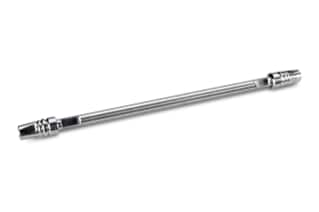
|
Chemistry |
CEL2 |
|
Separation Mode |
SuperCritical Fluid (SFC) |
|
Particle Substrate |
Silica |
|
Temperature Limits |
40 C |
|
Maximum Pressure |
6000 psi (415 Bar) |
|
Particle Shape |
Spherical |
|
Particle Size |
2.5 µm |
|
Endfitting Type |
Parker-style |
|
Format |
Column |
|
System |
SFC, UPC2 |
|
Technique |
SFC, SFC/MS |
|
Inner Diameter |
2.1 mm |
|
Length |
150 mm |
|
eCord |
Yes |
|
UNSPSC |
41115711 |
|
Brand |
Trefoil |
|
Product Type |
Columns |
|
Units per Package |
1 pk |
Trefoil CEL2 Column, 2.5 µm, 2.1 mm X 150 mm, 1/pk
To enable both selectivity and speed and to shorten the method development time, choose the Trefoil CEL2 Column to be able to produce quick, reliable chiral separations. Furthermore, the 2.5 m Trefoil CEL2 Column has the added performance of columns packed with tiny particles and is compatible with a wide range of mass spectrometers while giving the best peak shape and efficiency.
Use the Trefoil CEL2 Column to quickly and easily separate enantiomers, stereoisomers, metabolites, degradants, and contaminants. For broad-spectrum chiral selectivity, the Waters Trefoil CEL2 Column features a modified polysaccharide-coated stationary phase. Polysaccharides have distinct spatial orientations due to their higher-order structure, which allows for chiral selectivity via well-chosen modifications or selectors. You can improve selectivity even more by utilizing co-solvents and additive blends that regulate chiral recognition most favorably.
The lab equipment packing materials have been designed to be compatible with the ACQUITY UPC2 Systems and are produced in our ISO-certified facilities using only ultra-pure reagents. Furthermore, each batch of the Waters Trefoil CEL2 Column's packing material is tested, and the results are kept to rigorous criteria to ensure great results are supplied. Every column is individually tested, and the eCord Intelligent Chip includes a Performance Chromatogram and Certificate of Batch Analysis. The Certificate of Analysis is unique to each batch of packing material, whereas the Performance Chromatogram is unique to each column. The information on these reference materials should be saved for future use.
You can find all of Waters' product options, including analytical columns, guard columns, vials, and other equipment, by perusing our brochure or visiting our website, where you can shop for lab equipment and contact us with any questions or concerns or if you need any assistance.
We also recommend the LCMS Certified Clear Glass 12 x 32 mm Screw Neck Vial, with Cap and Preslit PTFE/Silicone Septum, 2 mL Volume, 100/pk; all Waters LCMS Certified vials are manufactured using tightly controlled manufacturing processes and handling procedures, and they are tested with mass spectrometers and come packaged with a certificate of analysis displaying the reference and vial scan for the manufacturing lot.
What Is The Maximum Pressure And Temperature The Trefoil CEL2 Column Can Operate Up To?
The Trefoil CEL2 Column can tolerate operating pressures up to 6000 psi (or 415 Bar) and 40 Degrees Celsius; however, you should note that working at the extremes of pressures, pH, and/or temperatures will result in shorter column lifetimes.